25 Points: The Book of Monelle
 The Book of Monelle
The Book of Monelle
by Marcel Schwob
translated by Kit Schluter
Wakefield Press, 2012
136 pages / $12.95 buy from Wakefield Press or Amazon
1. Let’s just start with the fact that this book made me cry. It’s an utterly heartbreaking book, beautiful in the torment and suffering that is manifested through its words. Though Monelle instructs, “Words are words while they are spoken. / Unspoken words are dead and beget the plague. / Listen to my spoken words, and act not according to the words I write,” these written words are the only spectral trace we have left of her.
2. I first heard about the new translation of this significant work at Harriet.
3. The synopsis of the book reads: When Marcel Schwob published The Book of Monelle in French in 1894, it immediately became the unofficial bible of the French symbolist movement, admired by such contemporaries as Stephane Mallarmé, Alfred Jarry, and André Gide. A carefully woven assemblage of legends, aphorisms, fairy tales, and nihilistic philosophy, it remains a deeply enigmatic and haunting work over a century later, a gathering of literary and personal ruins written in a style that evokes both the Brothers Grimm and Friedrich Nietzsche. The Book of Monelle was the fruit of Schwob’s intense emotional suffering over the loss of his love, a “girl of the streets” named Louise, whom he had befriended in 1891 and who succumbed to tuberculosis two years later. Transforming her into Monelle, the innocent prophet of destruction, Schwob tells the stories of her various sisters: girls succumbing to disillusion, caught between the misleading world of childlike fantasy and the bitter world of reality. This new translation reintroduces a true fin-de-siècle masterpiece into English.
4. The Book of Monelle is a book of words, like the Bible, these words may transcend its physical pages. In its biblical and prophetic tone, Monelle, perhaps herself a prophet, speaks of the beginning: “And Monelle said again: I shall speak to you of young prostitutes, and you shall know the beginning.”
5. If Monelle is a prophet, she is utterly of the present, of the moment, and of silence, because in life and suffering everything becomes a mirror to one’s suffering, and because in death there is only silence, but there is also the hope of forgetting.
6. Monelle instructs: “Do not remember, and do not predict.”
7. The translator gives two possible ways to interpret the name Monelle. First, the French translation that roughly translates into “My-her,” which implicates a strange hope for possession. Indeed, the narrator (whom we take to be Marcel’s tortured self) says, “And as I looked over the plain, I saw the sisters of Monelle rising.” Because every “her” is Monelle. And Monelle is every her. And yet, Monelle is of the past and infinitely elusive.
8. Monelle, its prefix derived from monos, then also implies a numeric singularity. Monelle is now and always alone. Schluter, in a footnote to his afterword, describes, “The infinite solitude that draws the narrator toward her is the very force that must ultimately repel him. In the end, no matter how we attempt to grasp her character, her name should be the first clue that Monelle will fade into abstraction in the fashion of a mirage or a dream recalled upon waking.”
9. Monelle speaks: “…for it is necessary that you lose me before you find me again. And if you find me again, I shall elude you once more. / For I am she who is alone.”
10. And then: “Because I am alone, you shall give me the name Monelle. But you shall imagine that I have every other name.” (Louise, Louvette, Lilly, Bargette…) READ MORE >
November 7th, 2012 / 1:01 pm
25 Points: Life of Pi
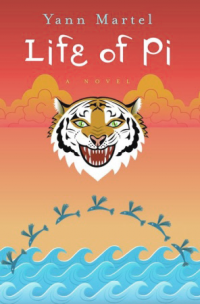 Life of Pi
Life of Pi
by Yann Martel
Knopf Canada, 2001
336 pages / $15.95 buy from Powell’s
1. Here’s a secret: I didn’t know what to think after finishing Yann Martel’s Life of Pi.
2. …I still don’t.
3. And I was baffled when I read reviews (tons of them) saying things like “omg this book will make you believe in God,” and “after reading Life of Pi, you’ll definitely never want to eat another animal again.” What the fuck? I thought I was reading a book.
4. Anyway, I guess it doesn’t help either that Ang Lee (Brokeback Mountain) has actually (finally) turned the book into a film.
5. It’s one thing for reviewers and normal people to say things (like how I am supposed to feel about the book) but when the author actually says stuff like “Yeah, this is totally gonna change your life,” in all seriousness, I feel like doing bad things to that author.
6. But Martel doesn’t actually say anything like that and I don’t really feel like I want to actually do bad things to authors or artists—ever. Really, Martel says something more like, “This book will make you believe in God…” Something like that.
7. And who the fuck do you think you are, Yann Martel? Is this how one wins the Man Booker? Because, I don’t know.
8. Confidence is one thing but this—this is just bullshit.
9. Question though (and this is relevant, maybe): If I hate this book so much, then why am I bothering to even read it? Well, it’s pretty simple. Basically, like I said, it won the Man Booker, and unfortunately (for me,) this is/was my first Man Booker so, I sorta kinda wanted to see what all the fuss is/was about. (And also, just because I don’t like a book doesn’t mean I won’t read it!) (Let alone review it.) (Come on!). Plus, it’s being turned into a movie so… READ MORE >
November 6th, 2012 / 6:37 pm
25 Points: Journey to the End of the Night
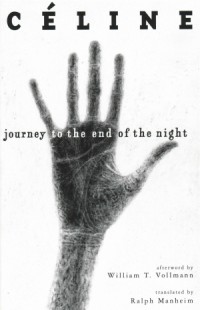 Journey to the End of the Night
Journey to the End of the Night
by Louis-Ferdinand Céline
New Directions, 2006
464 pages / $17.95 buy from New Directions
1. Will Self compared Joyce’s life before Ulysses to Céline’s experience in the war before writing Journey, in his exquisite discussion of the book upon some anniversary publication in The New York Times. I think I read that review about halfway through the novel and it complimented the thing quite well, gave a necessary contemporary slant on the whole thing.
2. Though remembered—much like Knut Hamsun—for his anti-Semitism (later in life) before his talents as an author after so many years gone by, a return to Céline and this novel in particular has occurred among authors and intellectuals almost every decade since its publication in 1932.
3. A new sort of manic transcription of the author’s experiences through his protagonist Ferdinand Bardamu jettisons the reader from war-torn France into the jungles of colonial Africa (my absolute favorite portion of any picaresque I’ve ever read) to post WWI America and back to France without missing a beat and yet the effect is akin to a hammer pounding against your chest.
4. I’ve read the book on three occasions, the last of which I suppose I felt ready enough and barreled through it in a couple of days and felt the aforementioned chest pounding that I’ve never experienced reading another book.
5. Its second translator, Ralph Manheim, also translated Adolf Hitler’s Mein Kampf.
6. Every time I remember that this is Céline’s first novel a little part of me that used to believe in writing as a career dies, then runs itself over in some hellish ghost tank, and dies again.
7. Famous for his use of three dots (“…”) in the sprawling paragraphs of his books, Céline—to me—has created a new and perfectly original way of de-Salinger-izing your first bildungsroman and turning it into a strange fucked up masterpiece.
8. Here we have the antihero, and the antihero’s doppelganger (in so many words) Robinson, who comes out of nowhere after any number of times to keep the protagonist company while he evades work, wanders around like a lunatic, and speculates about the desperate stupidity of mankind.
9. Bardamu’s a fan of kids, however; this being one of the few hopeful characteristics of the man. He believes in them, the promise of a good future, that maybe—just maybe—they won’t wind up shit like every adult he sees around.
10. The simplest characterization of this book is to say that it’s a picaresque, which is valid, but feels like the largest slight inflicted upon a great work of literature since everyone said all that shit that one time about your favorite whoever the hell; so I don’t want to do that. I want to call it a bible for people with less-than-hope but more-than-pettiness who hope to suck the congealed blood from the wounds of a better life forgone in the name of money, or democracy, or the nuclear family; and those who read it needing that companionship, needing that sense that all is not lost just yet, you’ll find it here. READ MORE >
November 1st, 2012 / 12:09 pm
25 Points: Darling
 Darling
Darling
by William Tester
Knopf, 1992
177 pages / $9.95 buy from Amazon
1. “I have this room inside my head, a lightless, nightmare kind of room that I pretend is where I am. A smaller me sits in its darkness.”
2. “My mama in her mirror smiles at her, ahold of me, jewelry, makeup, mother, child. She pets my cowlick down and pats me gentle swattings on my butt. She’ll take or leave me– queen of us. She’s pretty. Mama lets me know that she’s the most loved one of us. I move for room to let her sit beside me, scoot across the stool. I’ll flirt for her; I’ll court, or woo her with my smallness. I’m this big: my head tops even with her dresser, with my hand to make a bridge. It feels like I’m this bunch or bundle, six potatoes in a bag. This pet. A useless tiny person, me so close down to the ground, potato legs and chest and elbows, with my big potato head.”
3. “Her hair reminds me then of boards.”
4. “Sometimes her neck is like an animal alive inside of her.”
5. “By now I’ve half decided how it is we’re going to die, Jeab gone to elsewhere in his liquor, me– I’ve wallowed on the thought that I’ll be shot down like a dog, or struck with bricks fell from a window, held and throttled while some killer smacks a hammer through my skull in a squirt of pain.”
6. “It wanders backwards lost and blinded toward an ant bed death to come. Me, I’m a giant to the bug. I wonder what its tiny mind is like, what nonsense it must live.”
7. “I hear the gyroings and gears inside the belly of the world, oily and in tar– and in the sky, the set chain of the wider all– turns.”
8. “A kind of line in me connects me to the gym and chilly stalls, a line that draws me like a toy across the sky between my arms, the flapping, thuddy noise of sprinters, shouting, fearful coughing me.”
9. “Chlorine and sneaker smells of feet the taste of pennies dew our air.”
10. “He butts his head bone in her bag like he is eating her from out of her or pulling out her blood.” READ MORE >
October 31st, 2012 / 1:09 pm
25 Points: And So
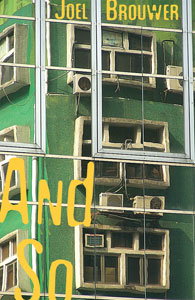 And So
And So
by Joel Brouwer
Four Way Books, 2009
88 pages / $15.95 buy from Four Way Books
1. And So was published in 2009, and so I’m reviewing it now, in 2012.
2. There’s always a time lapse in reading; and so we are all the silhouettes of each other’s ideas of fireflies.
3. Except: we aren’t all silhouettes of each other’s ideas of fireflies. Sometimes we cease to be apart and begin to be together in a way that is (and is not) like a dump cake. It is as Brouwer writes in “In a Motel Halfway to Omaha”: “At dawn she said she had to go to work and he / said not until I do it to you again slut / and she said ok whatever bad man and so” we go on with our dump cake selves.
4. People exist; people have sex. There are people in And So and so they have sex. A lot.
5. If And So were an album, it would be less Marvin Gaye’s Let’s Get It On and more Fiona Apple’s The Idler Wheel is Wiser Than the Driver of the Screw and Whipping Cords Will Serve You More Than Ropes Will Ever Do. And So is not a long title, and so it’s easier to say—which is more important than many things (like shallots).
6. And So is intimately concerned with its use of language, and so am I.
7. The cover art of And So is, to my mind, a series of frames, a series of ways of looking at things (read: people, relationships, the Mona Lisa). I am bothered by our inability to escape from frames, and so the cover art disturbs me.
8. As I break these thoughts to twenty-five pieces—as I frame them—I am wary of: the need for this review; the time that has elapsed between the publishing of this book and the writing of this review; the need for this form for this review; my place in this review; the book’s place in this review; if this review is actually even a review, or if it is a personal essay, co-opting this strange and lovely book of Brouwer’s for its (my) own purpose. I am wary, and so I do what I always do when I am wary: I tell you.
9. But if this were a personal essay, wouldn’t I tell you about my mother, her schizophrenia? I’m not telling you, and so it can’t be a personal essay.
10. But now I’ve told you, and so it must be. Perhaps it always is/was. READ MORE >
October 30th, 2012 / 8:05 pm
25 Points: 20 Lines a Day
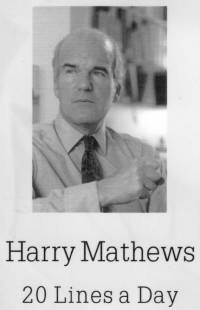 20 Lines a Day
20 Lines a Day
by Harry Mathews
Dalkey Archive Press, 1988
134 pages / $10.95 buy from Dalkey
1. In the fifth floor of the library, I picked the book up, read what the premise was, and thought resentfully, “What a bunch of bullshit, this looks boring, look how anything gets published.” I didn’t know who Harry Mathews was yet. Years ago.
2. “You never have earned the right to sit at the table and let someone else clear away the dishes. No accumulation of knowledge can guarantee that you aren’t a fool. The roast is over-cooked. You slice bread for the seven-hundredth time and cut off the tip of your left forefinger. You touch her as coarsely as any boor, being now the boor. You meet an old friend, you have forgotten his name, you cannot look him in the face: not looking him in the face, you wound him and you start lying to him and to yourself. Go off and sulk and complain and explain why it happened. It won’t help. Instead, be an actor, or an athlete, on stage, on the field, giving–as you once eagerly proposed to yourself–everything to the perishable act.”
3. “I have nothing to write in particular, I’m writing these lines because of my rule that I must write them.”
4. Some writers set quotas, others set routines, some set both, and some (the scriptomanic ones for whom procrastination is not a threat) set neither. A page a day (Paul Theroux); 50,000 words in a month (NaNoWriMo); two hours every morning (W.S. Maugham); 20 minute blocks (Cory Doctorow); at least a sentence a day (W.G. Sebald); pre-dawn (Paul Valéry, Jacques Roubaud); etc.
5. “Whatever I write tells my story without my knowing it.”
6. “Let no thought pass incognito, and keep your notebook as strictly as the authorities keep their register of aliens.” (Walter Benjamin, “One Way Street,” Reflections)
7. “Sometimes the ultimate message is in fact received. It reads, more or less: ‘Your ligament issues from a spa that is given various narcissisms at various time-tables: lozenge, credulity, goggles. And not only your ligament (and that of others): the prodigy that generates mayday has the same orthography. You and the upkeep are one. Give up sugarbowls.’ At such moments you realize, and you remember, that such messages have never been lacking, and that they are all the same, and that the problem (if that is the word) doesn’t involve receiving but deciphering what is received again and again, day after day, minute after minute.”
8. There’s an implicit link between 20 Lines a Day and the next novel Mathews would publish, The Journalist (1994). One sees how the method Mathews followed for 20 Lines is adopted as a fictional premise and device for The Journalist.
9. “Anxiety about writing feels like: I am poor in words, ideas, and feelings, and when I sit down to write, this poverty will be revealed.”
10. “The table is a beautiful thing. The writing board is supported on a base consisting of two tubular legs shaped like narrow inverted U’s, with a tubular foot running across the mouth of each U, projecting about thirty centimeters beyond it on either side. The legs are connected to the board by an adjustable parallelogram made of bone-shaped pieces of flat metal. The knobs of the bones are pierced with pivotal studs that hold the sides of the parallelogram together. Two strong springs, to hold the angles in place, maintain pressure against two other springs fixed just below the board. A single lever controls this disposition and locks the board in place. Changing the angles of the parallelogram permits one to alter both the height and angle of the board in one movement. Board, parallelogram, legs and feet are white; springs, studs, and lever handle are black.” READ MORE >
October 25th, 2012 / 9:09 am
25 Points: Lew Welch
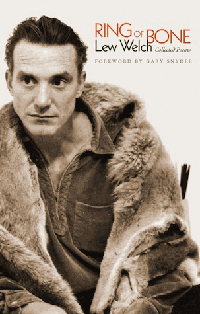 Ring of Bone: Collected Poems
Ring of Bone: Collected Poems
by Lew Welch
City Lights Publishers, 2012
252 pages / $17.95 buy from City Lights
1. I’ve been reading Lew Welch for some 20 odd years. First I read Edgar Allen Poe, Allen Ginsberg, Walt Whitman, Hawthorne, Thoreau et al and then I found out about Kenneth Rexroth, Gary Snyder, and Lew Welch. (I heard of Philip Whalen too but he took a while longer for me to dig)
2. Welch met Whalen and Snyder when all were students together @ Reed College in Portland, OR on lawns where I once threw a Frisbee (was it?) several years ago with my pal Jeffrey Butler and his son Austin. And then a couple years later went back to see the JESS show. Lately I’ve been avoiding phone calls. I only talk to my mom. I owe Jeffrey Butler up in PDX a good long chat one of these days.
3. When I read Lew Welch I often think about Robinson Jeffers (and vice versa)
“I’m the ghost Roan Stallion” – Lew Welch
4. Both Leos, we’re born August 16th
LEO MENAGERIE
Sunnylyn Thibodeaux, Lew Welch, and me.
5. “You know Lew always CRIES when he reads and it will ruin the evening.”
–Joanne Kyger. http://jacketmagazine.com/27/w-kyge.html
6. David Highsmith gave me a broadside, “Raid Kills Bugs Dead” for my birthday one year. It’s up in our bathroom. This tag-line, ad copy throwaway, now emblazoned in millions of modern day minds, is attributed to Welch from his 9-5 Chicago workadays.
7. Huey Lewis of Huey Lewis and the News is Welch’s step-son. He sang Welch’s “Graffiti” with his mother in the audience @ SF Public Library. Dig it: http://youtu.be/N5diFN_Gpx4
8. Welch walked off with his gun never to be seen again.
9. Tall and lanky with a bursting head of red describes Lew Welch as if he was a good looking woman.
10. Before any poet bothers to write a poem concerning problems of rat infestation they should be familiar with Welch’s “Buddhist Bard Turns Rat Slayer” especially if they consider themselves to be Buddhist and are a “professor” in the Bay Area. READ MORE >
October 24th, 2012 / 6:38 pm
25 POINTS APPROACHING THE MEMOIRS OF JONBENET BY KATHY ACKER BY MICHAEL DU PLESSIS
 The Memoirs of JonBenet by Kathy Acker
The Memoirs of JonBenet by Kathy Acker
by Michael du Plessis
Les Figues Press, 2012
103 pages / $15.00 buy from Les Figues Press
1. I have only read one true-crime novel or account or whatever they’re called within the genre–if you count Peter Sotos as a true crime author (why would you?) I guess this is a false statement–a book on JonBenet, and it was sort of astounding and blew my mind. I know most of these true crime books are about two steps away from conspiracy theorists & 9/11 truthers, but ultimately the way evidence is presented, if not actual evidence, creates a new world of fiction that is both troubling and astounding.
2. And as such I’ve had a JonBenet obsession ever since. There’s a gross collaboration going on within the recounting of the JonBenet narrative: the young white princess of middle america challenged by a vicious S/M monster snuff ring kiddie porn mystery. And perhaps the perpetrator was her parents? It’s like the pool party at the Hard Rock Casino in Vegas; this is the true avant-garde of American letters, the fuckTness of the popular zeitgeist.
3. Then there’s Kathy Acker, who I want to haunt me like the sun does, and she does sometimes, and she surrounds the air of the people I eat dinner with here in San Francisco.
4. Kathy Acker is a force invented by both fiction and second-hand statements that act as a guide when the bullshit becomes too much.
5. Have I mentioned there is also a chapter where JonBenet as Kathy Acker (or the other way around) is O from Story of O (which retains such a more beautiful sounding title en francais, Histoire D’O) and Rene is nowhere to be found and certainly NOT Little Lord Fauntelroy but rather Boulder is Roissy somehow and the carpet is all similar and the entire facade crumbles under the watchful eyes of O I mean JonBenet I mean Kathy Acker I mean Michael Du Plessis.
6. Right now, while writing this, I am hungry and want to go make myself a sandwich but I’m trying to stave off the hunger until this is finished because JonBenet is a doll and a doll is not real and dolls do not have to eat to sustain themselves and TO BE REAL IS THE WORST.
7. Nothing in this novel moves in a linear fashion. Events happen and then other events happen but there is certainly not any discernible narrative arc unless you literally construct one out of “your ass” which, I suppose, is possible, but ultimately not within the diegesis of the novel itself.
8. Of course what I mean by the above point is that within this realm of circumstantial ‘realism’ that may or may not be what the point of contention on this blog even is lately, it’s ultimately futile when you realize that modernity is over (jesus christ get over it) and we are all so post-grand-narrative that the way things move is LIKE THIS, okay? Yesterday I went to work I ate a pretzel I took like three shits I sat on some stairs I read a Franck André Jammes book I took the BART to my boyfriend’s house and then I passed out without having sex because I was feeling exhausted HI THIS IS HOW NARRATIVE WORKS IN REAL LIFE, WHAT THE HELL IS THIS REALISM SHIT.
9. It’s like the way narrative works in this book is how Kathy Acker understood narrative which means, both, that Du Plessis understands Acker and that both Acker and Du Plessis understand narrative.
10. What I mean by this is the movement in this book is gorgeous but stilted which makes it even more beautiful. Why are we reading? READ MORE >
October 18th, 2012 / 2:40 pm
25 Points: Last Exit to Brooklyn
 Last Exit to Brooklyn
Last Exit to Brooklyn
by Hubert Selby Jr.
Grove Press, 1964
320 pages / $7.95 buy from Powell’s
1. Finished on C train from Bronx to Bed-Stuy.
3. People of Last Exit (they are people, not so much characters): pimps, widows, trannies, fairies, strikers, scabs, bullies, gang members, factory workers, MPs, doggies, fathers, policemen, mothers, prostitutes, sons, convicts, daughters, addicts, the confused, the disadvantaged, the struggling, everyone poor, everyone violent in some way. No one this reviewer knows is violent.
5. “She tilted her head toward the radio and listened to the hard sounds piling up on each other, yet not touching, wanting to hold Vinnies hand, the strange beautiful sounds (bennie, tea and gin too) moving her to a strange romance where love was born of affection, not sex; wanting to share just this, just these three minutes of the Bird with Vinnie, these three minute sour of space and time and just stand together, perhaps their hands touting, not speaking, yet knowing…just stand complete with and for each other not as man and woman or two men, not as friends or lovers, but as two who love…these three minutes together in a world of beauty, a world where there wasnt even a memory of johns or punks, butch queens or Arthurs, just the now of love…” Note: Ellipses are in text, not of this reviewer’s hand.
7. People drink beer or gin. Whisky is not overly mentioned.
8. “A cigarette only takes a certain amount of time to smoke and though this takes time it seems to take less and less with each one and you can only smoke so many, there comes a time when you have to stop, when you just cant light the next one…at least not for awhile.”
9. People bump into corners of desks on accident. Then they move on.
10. Last Exit was first published in 1957. Selby was 29. He died in 2004. The year today is 2012. READ MORE >
October 17th, 2012 / 9:11 am
25 Points: The Killer Inside Me
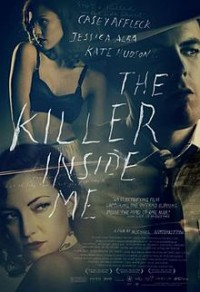 The Killer Inside Me
The Killer Inside Me
by Jim Thompson
Vintage, 1991
256 pages / $14.95 buy from Powell’s
1. Lou Ford is a small town sheriff who kills people in extremely gruesome ways (though the language chosen to describe it is subdued).
2. He strikes everyone in town as a moron, and somehow when he starts killing this makes it all the more irksome.
3. Stanley Kubrick called it “probably the most chilling and believable first-person story of a criminally warped mind I have ever encountered.” And he was correct.
4. The novel’s author, Jim Thompson, was known as Dimestore Dostoyevsky, which is also correct.
5. Lou Ford takes a lot of baths and reading this in a hot bathtub is very difficult.
6. Jim Thompson is one of the most intriguing figures to ever write a story about a killer and—unlike most—he does it best in the first person.
7. The ending will probably make you wish you were still in the thick of the narrative, which is either a sign of the novel’s excellence or an observation that ending something this strange and unconventional is not-fucking-easy.
8. Lou Ford takes to bashing around a hooker named Joyce Lakeland, who likes it a great deal and encourages him to keep coming back.
9. Casey Affleck stars in a film rendition of this book that recently came out and although it’s pretty spot on I think you’ll find when reading that some things just cannot translate.
10. Though the convention of the cops being on the killer’s tail plays a part in this book you’re hardly on the edge of your seat wondering about the morality being discussed here; this is, more than anything, a work of art by an artist before it is a poorly-crafted slice of genre fiction. READ MORE >
October 16th, 2012 / 9:09 am
